Stereotypes at Workplace: An Analysis of Merits and Problems
VerifiedAdded on 2023/06/12
|7
|2109
|234
Essay
AI Summary
This essay examines the merits and problems of stereotyping in the workplace and its impact on organizational behavior. It defines stereotypes as shared characteristics within a group and explores how they can influence management's perception and customization of products and services. The essay discusses the challenges arising from increased diversity, such as communication and teamwork issues, and emphasizes the role of HRM in promoting a unified organizational culture. It also addresses the potential misapplication of stereotypes, leading to employee dissatisfaction and decreased performance. The essay highlights the importance of proper organizational policies and the use of real-world examples like Wesfarmers to illustrate successful diversity management. Furthermore, it delves into the benefits of stereotyping for managers in creating a positive work environment and formulating effective teams, especially in international business expansion. The essay also acknowledges the negative aspects of stereotyping, including discrimination and the creation of toxic work environments, and suggests motivational theories like Maslow's hierarchy of needs and ERG theory to mitigate these issues. Finally, it concludes by emphasizing the need for management to implement strong diversity policies and training programs to leverage the benefits of stereotyping while minimizing its drawbacks.
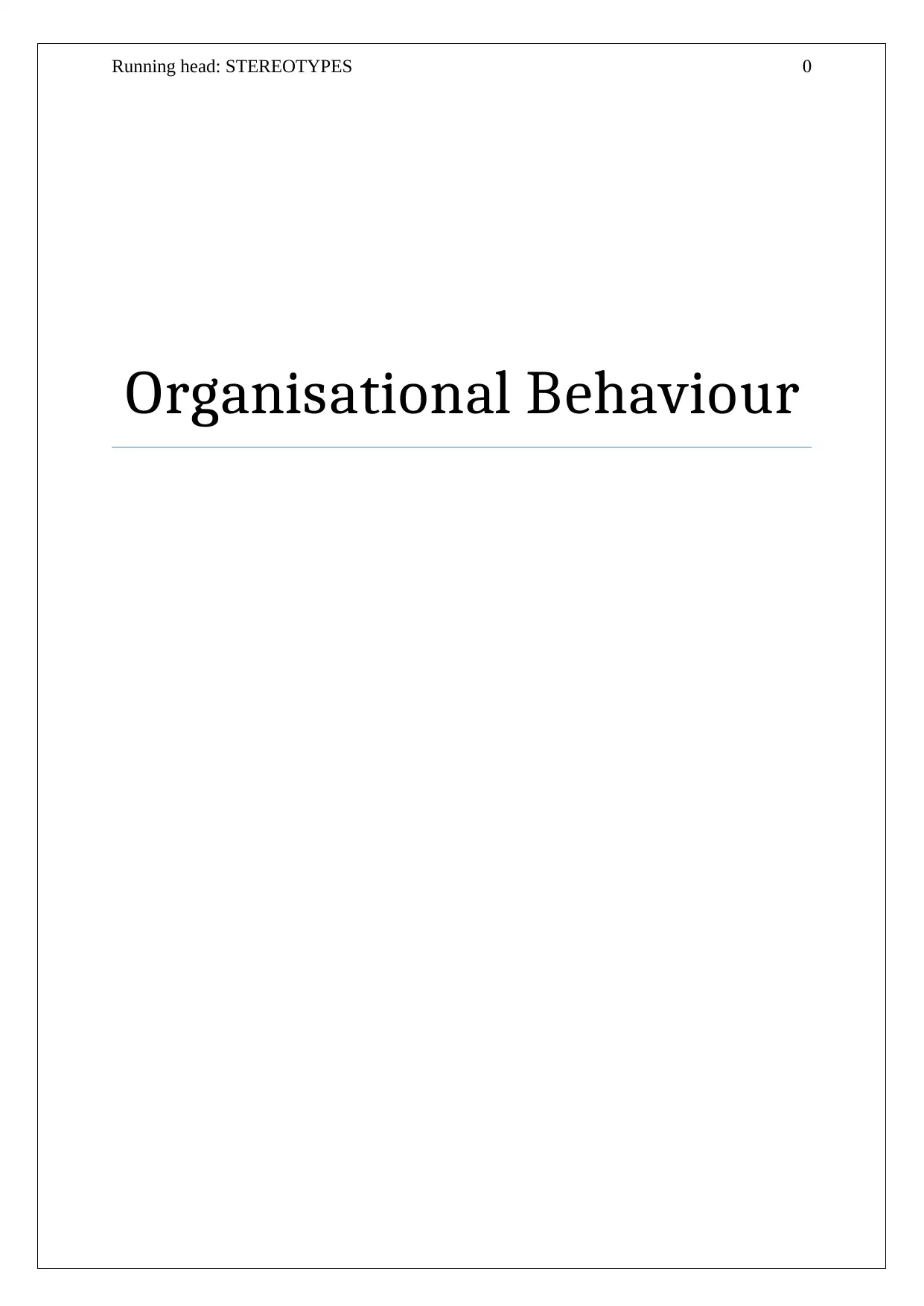
Running head: STEREOTYPES 0
Organisational Behaviour
Organisational Behaviour
Paraphrase This Document
Need a fresh take? Get an instant paraphrase of this document with our AI Paraphraser
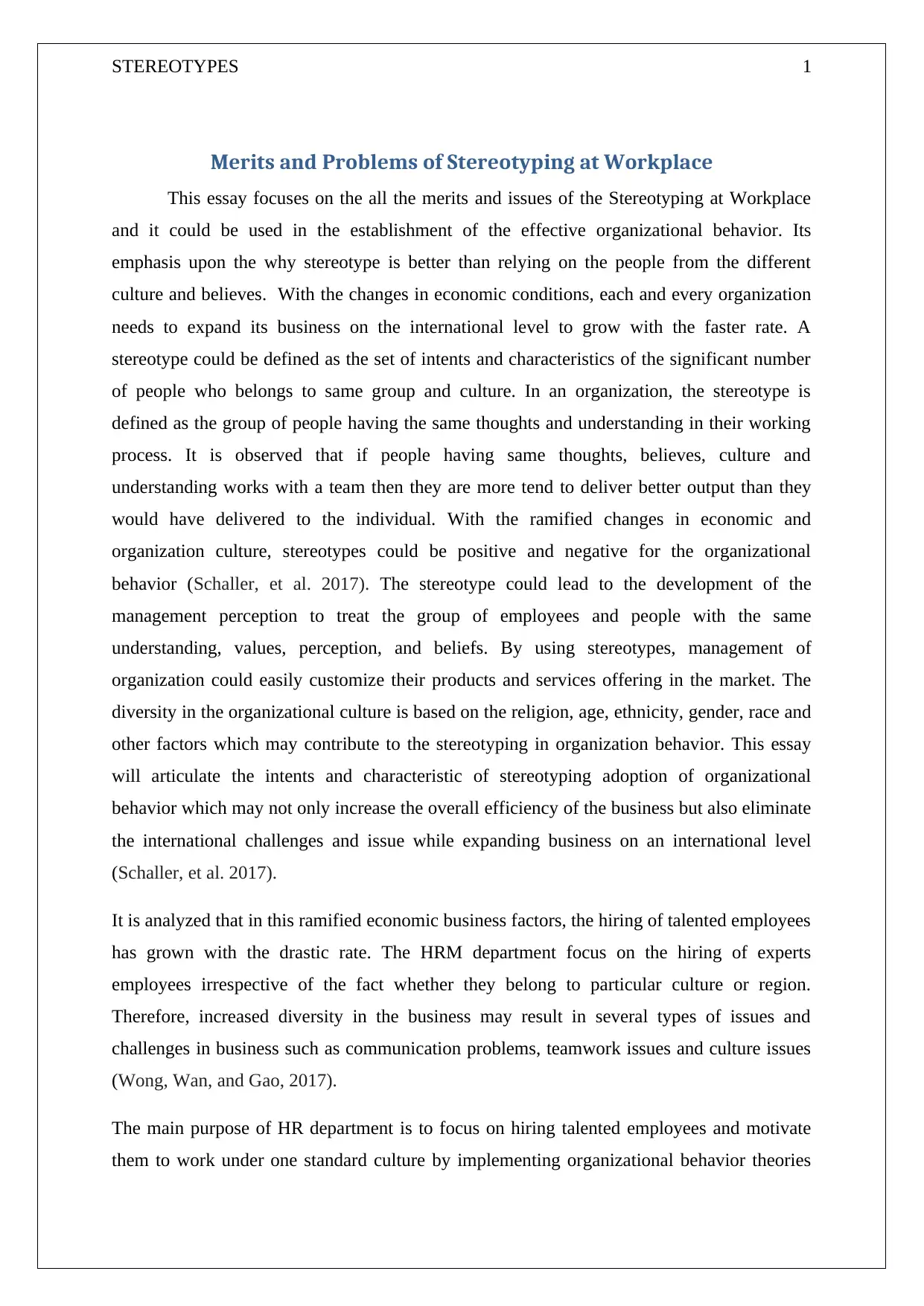
STEREOTYPES 1
Merits and Problems of Stereotyping at Workplace
This essay focuses on the all the merits and issues of the Stereotyping at Workplace
and it could be used in the establishment of the effective organizational behavior. Its
emphasis upon the why stereotype is better than relying on the people from the different
culture and believes. With the changes in economic conditions, each and every organization
needs to expand its business on the international level to grow with the faster rate. A
stereotype could be defined as the set of intents and characteristics of the significant number
of people who belongs to same group and culture. In an organization, the stereotype is
defined as the group of people having the same thoughts and understanding in their working
process. It is observed that if people having same thoughts, believes, culture and
understanding works with a team then they are more tend to deliver better output than they
would have delivered to the individual. With the ramified changes in economic and
organization culture, stereotypes could be positive and negative for the organizational
behavior (Schaller, et al. 2017). The stereotype could lead to the development of the
management perception to treat the group of employees and people with the same
understanding, values, perception, and beliefs. By using stereotypes, management of
organization could easily customize their products and services offering in the market. The
diversity in the organizational culture is based on the religion, age, ethnicity, gender, race and
other factors which may contribute to the stereotyping in organization behavior. This essay
will articulate the intents and characteristic of stereotyping adoption of organizational
behavior which may not only increase the overall efficiency of the business but also eliminate
the international challenges and issue while expanding business on an international level
(Schaller, et al. 2017).
It is analyzed that in this ramified economic business factors, the hiring of talented employees
has grown with the drastic rate. The HRM department focus on the hiring of experts
employees irrespective of the fact whether they belong to particular culture or region.
Therefore, increased diversity in the business may result in several types of issues and
challenges in business such as communication problems, teamwork issues and culture issues
(Wong, Wan, and Gao, 2017).
The main purpose of HR department is to focus on hiring talented employees and motivate
them to work under one standard culture by implementing organizational behavior theories
Merits and Problems of Stereotyping at Workplace
This essay focuses on the all the merits and issues of the Stereotyping at Workplace
and it could be used in the establishment of the effective organizational behavior. Its
emphasis upon the why stereotype is better than relying on the people from the different
culture and believes. With the changes in economic conditions, each and every organization
needs to expand its business on the international level to grow with the faster rate. A
stereotype could be defined as the set of intents and characteristics of the significant number
of people who belongs to same group and culture. In an organization, the stereotype is
defined as the group of people having the same thoughts and understanding in their working
process. It is observed that if people having same thoughts, believes, culture and
understanding works with a team then they are more tend to deliver better output than they
would have delivered to the individual. With the ramified changes in economic and
organization culture, stereotypes could be positive and negative for the organizational
behavior (Schaller, et al. 2017). The stereotype could lead to the development of the
management perception to treat the group of employees and people with the same
understanding, values, perception, and beliefs. By using stereotypes, management of
organization could easily customize their products and services offering in the market. The
diversity in the organizational culture is based on the religion, age, ethnicity, gender, race and
other factors which may contribute to the stereotyping in organization behavior. This essay
will articulate the intents and characteristic of stereotyping adoption of organizational
behavior which may not only increase the overall efficiency of the business but also eliminate
the international challenges and issue while expanding business on an international level
(Schaller, et al. 2017).
It is analyzed that in this ramified economic business factors, the hiring of talented employees
has grown with the drastic rate. The HRM department focus on the hiring of experts
employees irrespective of the fact whether they belong to particular culture or region.
Therefore, increased diversity in the business may result in several types of issues and
challenges in business such as communication problems, teamwork issues and culture issues
(Wong, Wan, and Gao, 2017).
The main purpose of HR department is to focus on hiring talented employees and motivate
them to work under one standard culture by implementing organizational behavior theories

STEREOTYPES 2
and training program irrespective of their thoughts, believes, culture and understanding.
Organizational behavior could be defined as the study of the individual working, reaction and
the way they communicate within the group. The organizational behavior not only assists in
implementing effective HRM policies and program but also increases the overall efficiency
of the organization at large. The main problem related to stereotype is related to its
misapplication in the processing system of organization. It increases the dissatisfaction in the
employees and less efficient job performance (Kotni, and Karumuri, 2018). It also increases
the insensitive job behavior of employees which may destruct the value chain activities of the
organization. If the proper stereotype is not used then it will not only hamper the job
performance but also increase the overall cost of production of business. Ultimately, it will
negatively impact the business performance of the organization. Diversity in the work culture
could be managed by the proper organizational policies program and implement the effective
organizational culture. If proper stereotype function is used then it will not only result in
increased competitive advantage but also increases the overall output of the business. It could
be evaluated by using the real example, Wesfarmers, a retail store chain, working in
Australia, made HR policies which focus on the diversified work culture. It promotes people
from different culture and belief to work and learn together. In the recent case, Wesfarmers
hired more than 20% women employees to promote diversity in its business. This
organizational behavior of Wesfarmers not only increases its work condition but also
strengthen the brand image of the company at large (Scheffer, and Heckhausen, 2018).
In context to the merits of the stereotyping in the business functioning of the organization, it
could be inferred that stereotyping is beneficial for the managers to work effectively and
develop positive mindset for the new employees. It will assist them to ensure that other co-
workers are feeling comfortable and not making any insensitive remark about their work. The
stereotyping work culture also emphasis upon the management focuses and organizational
policies that need to be more clients oriented. The managers of the company use stereotyping
to evaluate their thoughts believes, culture and understanding work. It assists them to
formulate effective team which will eventually result in the creation of synergy (Kenrick,
2017).
In case if the company wants to expand its busienss on the international level, then by using
the stereotype, the manager could focus on hiring employees from that particular culture. It is
analyzed that if the organization sets its business in other nation then instead of migrating
experienced employees in particular country, it should focus on hiring employees from that
and training program irrespective of their thoughts, believes, culture and understanding.
Organizational behavior could be defined as the study of the individual working, reaction and
the way they communicate within the group. The organizational behavior not only assists in
implementing effective HRM policies and program but also increases the overall efficiency
of the organization at large. The main problem related to stereotype is related to its
misapplication in the processing system of organization. It increases the dissatisfaction in the
employees and less efficient job performance (Kotni, and Karumuri, 2018). It also increases
the insensitive job behavior of employees which may destruct the value chain activities of the
organization. If the proper stereotype is not used then it will not only hamper the job
performance but also increase the overall cost of production of business. Ultimately, it will
negatively impact the business performance of the organization. Diversity in the work culture
could be managed by the proper organizational policies program and implement the effective
organizational culture. If proper stereotype function is used then it will not only result in
increased competitive advantage but also increases the overall output of the business. It could
be evaluated by using the real example, Wesfarmers, a retail store chain, working in
Australia, made HR policies which focus on the diversified work culture. It promotes people
from different culture and belief to work and learn together. In the recent case, Wesfarmers
hired more than 20% women employees to promote diversity in its business. This
organizational behavior of Wesfarmers not only increases its work condition but also
strengthen the brand image of the company at large (Scheffer, and Heckhausen, 2018).
In context to the merits of the stereotyping in the business functioning of the organization, it
could be inferred that stereotyping is beneficial for the managers to work effectively and
develop positive mindset for the new employees. It will assist them to ensure that other co-
workers are feeling comfortable and not making any insensitive remark about their work. The
stereotyping work culture also emphasis upon the management focuses and organizational
policies that need to be more clients oriented. The managers of the company use stereotyping
to evaluate their thoughts believes, culture and understanding work. It assists them to
formulate effective team which will eventually result in the creation of synergy (Kenrick,
2017).
In case if the company wants to expand its busienss on the international level, then by using
the stereotype, the manager could focus on hiring employees from that particular culture. It is
analyzed that if the organization sets its business in other nation then instead of migrating
experienced employees in particular country, it should focus on hiring employees from that
⊘ This is a preview!⊘
Do you want full access?
Subscribe today to unlock all pages.

Trusted by 1+ million students worldwide
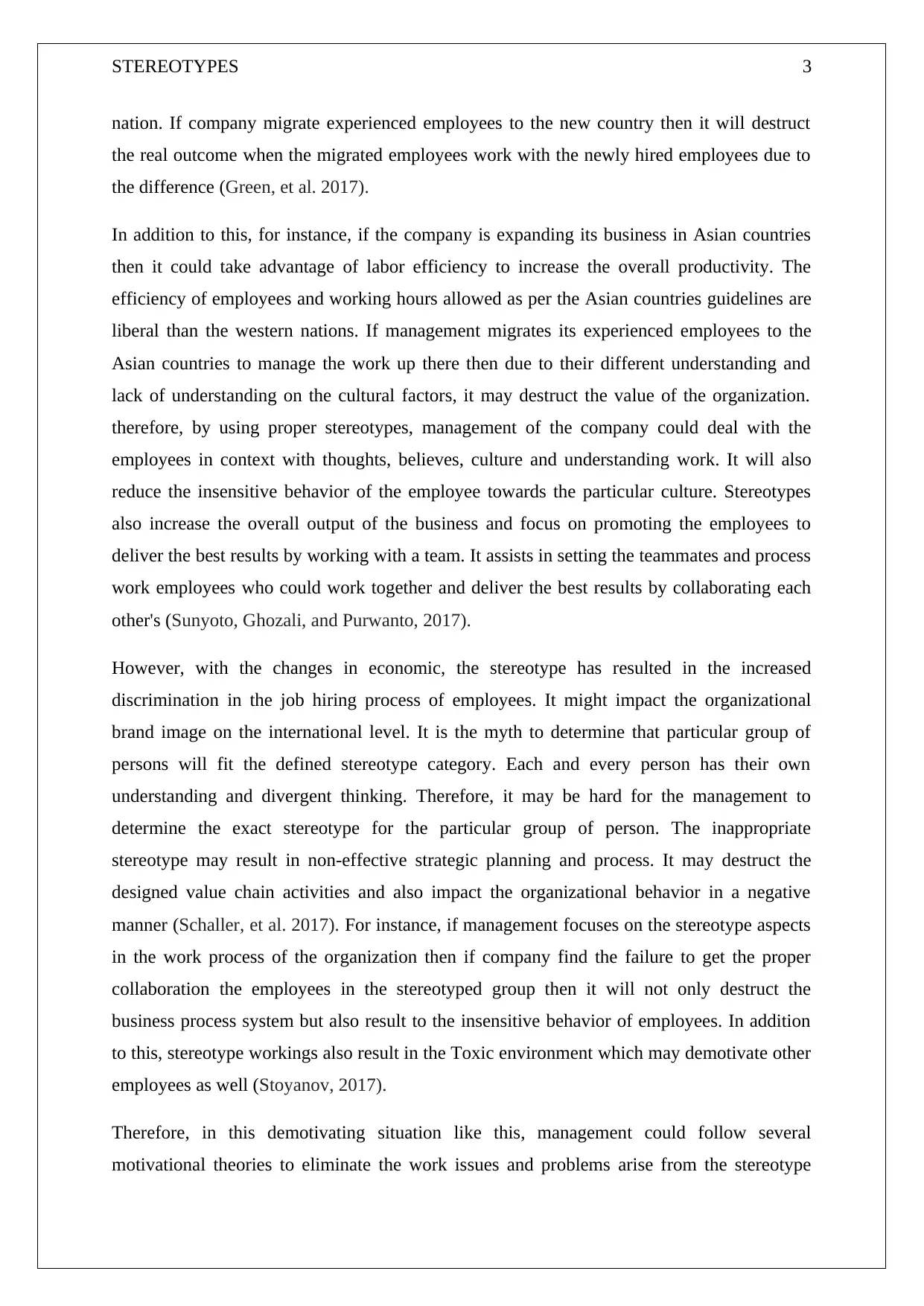
STEREOTYPES 3
nation. If company migrate experienced employees to the new country then it will destruct
the real outcome when the migrated employees work with the newly hired employees due to
the difference (Green, et al. 2017).
In addition to this, for instance, if the company is expanding its business in Asian countries
then it could take advantage of labor efficiency to increase the overall productivity. The
efficiency of employees and working hours allowed as per the Asian countries guidelines are
liberal than the western nations. If management migrates its experienced employees to the
Asian countries to manage the work up there then due to their different understanding and
lack of understanding on the cultural factors, it may destruct the value of the organization.
therefore, by using proper stereotypes, management of the company could deal with the
employees in context with thoughts, believes, culture and understanding work. It will also
reduce the insensitive behavior of the employee towards the particular culture. Stereotypes
also increase the overall output of the business and focus on promoting the employees to
deliver the best results by working with a team. It assists in setting the teammates and process
work employees who could work together and deliver the best results by collaborating each
other's (Sunyoto, Ghozali, and Purwanto, 2017).
However, with the changes in economic, the stereotype has resulted in the increased
discrimination in the job hiring process of employees. It might impact the organizational
brand image on the international level. It is the myth to determine that particular group of
persons will fit the defined stereotype category. Each and every person has their own
understanding and divergent thinking. Therefore, it may be hard for the management to
determine the exact stereotype for the particular group of person. The inappropriate
stereotype may result in non-effective strategic planning and process. It may destruct the
designed value chain activities and also impact the organizational behavior in a negative
manner (Schaller, et al. 2017). For instance, if management focuses on the stereotype aspects
in the work process of the organization then if company find the failure to get the proper
collaboration the employees in the stereotyped group then it will not only destruct the
business process system but also result to the insensitive behavior of employees. In addition
to this, stereotype workings also result in the Toxic environment which may demotivate other
employees as well (Stoyanov, 2017).
Therefore, in this demotivating situation like this, management could follow several
motivational theories to eliminate the work issues and problems arise from the stereotype
nation. If company migrate experienced employees to the new country then it will destruct
the real outcome when the migrated employees work with the newly hired employees due to
the difference (Green, et al. 2017).
In addition to this, for instance, if the company is expanding its business in Asian countries
then it could take advantage of labor efficiency to increase the overall productivity. The
efficiency of employees and working hours allowed as per the Asian countries guidelines are
liberal than the western nations. If management migrates its experienced employees to the
Asian countries to manage the work up there then due to their different understanding and
lack of understanding on the cultural factors, it may destruct the value of the organization.
therefore, by using proper stereotypes, management of the company could deal with the
employees in context with thoughts, believes, culture and understanding work. It will also
reduce the insensitive behavior of the employee towards the particular culture. Stereotypes
also increase the overall output of the business and focus on promoting the employees to
deliver the best results by working with a team. It assists in setting the teammates and process
work employees who could work together and deliver the best results by collaborating each
other's (Sunyoto, Ghozali, and Purwanto, 2017).
However, with the changes in economic, the stereotype has resulted in the increased
discrimination in the job hiring process of employees. It might impact the organizational
brand image on the international level. It is the myth to determine that particular group of
persons will fit the defined stereotype category. Each and every person has their own
understanding and divergent thinking. Therefore, it may be hard for the management to
determine the exact stereotype for the particular group of person. The inappropriate
stereotype may result in non-effective strategic planning and process. It may destruct the
designed value chain activities and also impact the organizational behavior in a negative
manner (Schaller, et al. 2017). For instance, if management focuses on the stereotype aspects
in the work process of the organization then if company find the failure to get the proper
collaboration the employees in the stereotyped group then it will not only destruct the
business process system but also result to the insensitive behavior of employees. In addition
to this, stereotype workings also result in the Toxic environment which may demotivate other
employees as well (Stoyanov, 2017).
Therefore, in this demotivating situation like this, management could follow several
motivational theories to eliminate the work issues and problems arise from the stereotype
Paraphrase This Document
Need a fresh take? Get an instant paraphrase of this document with our AI Paraphraser
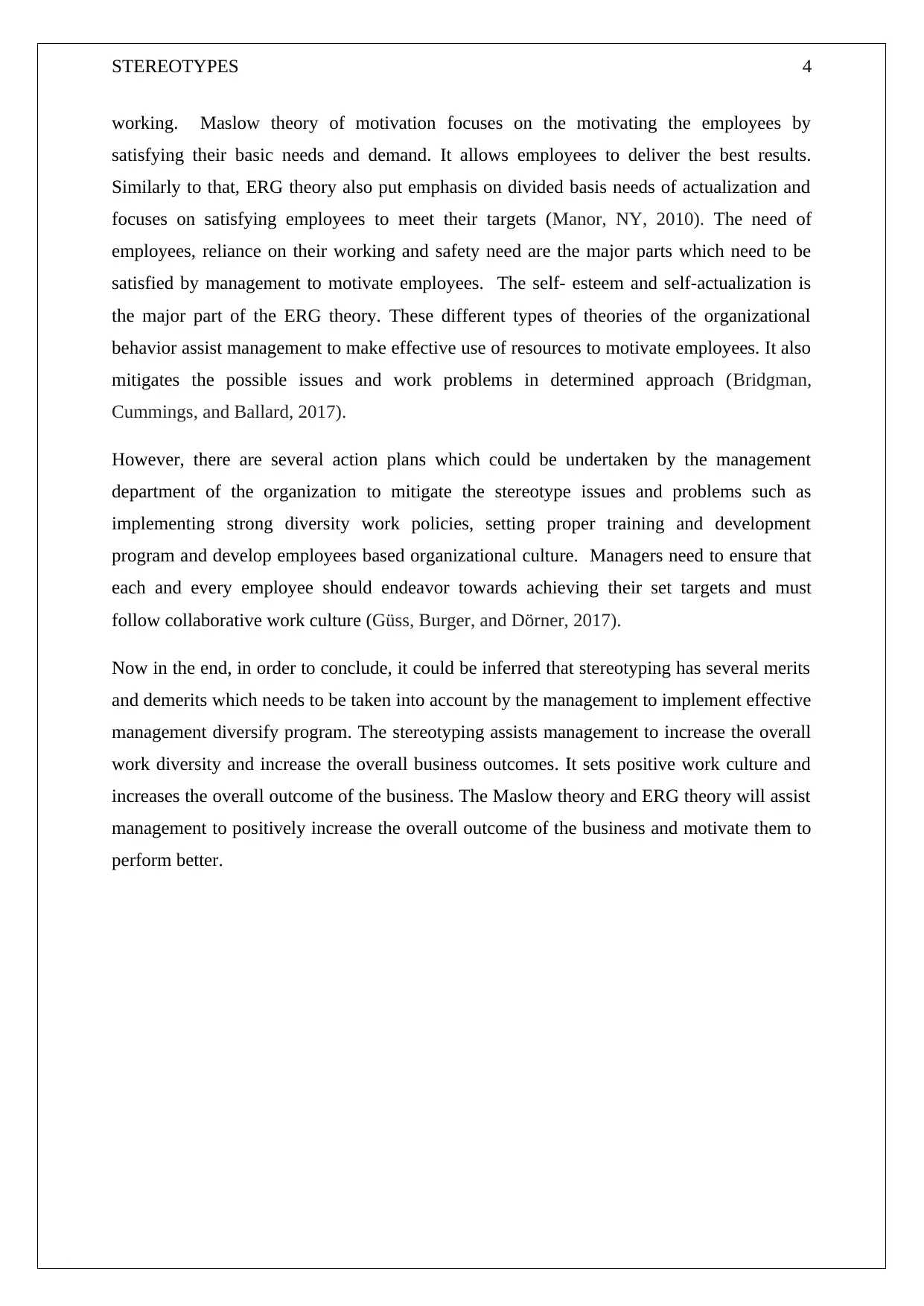
STEREOTYPES 4
working. Maslow theory of motivation focuses on the motivating the employees by
satisfying their basic needs and demand. It allows employees to deliver the best results.
Similarly to that, ERG theory also put emphasis on divided basis needs of actualization and
focuses on satisfying employees to meet their targets (Manor, NY, 2010). The need of
employees, reliance on their working and safety need are the major parts which need to be
satisfied by management to motivate employees. The self- esteem and self-actualization is
the major part of the ERG theory. These different types of theories of the organizational
behavior assist management to make effective use of resources to motivate employees. It also
mitigates the possible issues and work problems in determined approach (Bridgman,
Cummings, and Ballard, 2017).
However, there are several action plans which could be undertaken by the management
department of the organization to mitigate the stereotype issues and problems such as
implementing strong diversity work policies, setting proper training and development
program and develop employees based organizational culture. Managers need to ensure that
each and every employee should endeavor towards achieving their set targets and must
follow collaborative work culture (Güss, Burger, and Dörner, 2017).
Now in the end, in order to conclude, it could be inferred that stereotyping has several merits
and demerits which needs to be taken into account by the management to implement effective
management diversify program. The stereotyping assists management to increase the overall
work diversity and increase the overall business outcomes. It sets positive work culture and
increases the overall outcome of the business. The Maslow theory and ERG theory will assist
management to positively increase the overall outcome of the business and motivate them to
perform better.
working. Maslow theory of motivation focuses on the motivating the employees by
satisfying their basic needs and demand. It allows employees to deliver the best results.
Similarly to that, ERG theory also put emphasis on divided basis needs of actualization and
focuses on satisfying employees to meet their targets (Manor, NY, 2010). The need of
employees, reliance on their working and safety need are the major parts which need to be
satisfied by management to motivate employees. The self- esteem and self-actualization is
the major part of the ERG theory. These different types of theories of the organizational
behavior assist management to make effective use of resources to motivate employees. It also
mitigates the possible issues and work problems in determined approach (Bridgman,
Cummings, and Ballard, 2017).
However, there are several action plans which could be undertaken by the management
department of the organization to mitigate the stereotype issues and problems such as
implementing strong diversity work policies, setting proper training and development
program and develop employees based organizational culture. Managers need to ensure that
each and every employee should endeavor towards achieving their set targets and must
follow collaborative work culture (Güss, Burger, and Dörner, 2017).
Now in the end, in order to conclude, it could be inferred that stereotyping has several merits
and demerits which needs to be taken into account by the management to implement effective
management diversify program. The stereotyping assists management to increase the overall
work diversity and increase the overall business outcomes. It sets positive work culture and
increases the overall outcome of the business. The Maslow theory and ERG theory will assist
management to positively increase the overall outcome of the business and motivate them to
perform better.

STEREOTYPES 5
References
Bridgman, T., Cummings, S. and Ballard, J.A., 2017. Triangulating Maslow's Hierarchy of
Needs: The Construction of Management Studies' Famous Pyramid. In Academy of
Management Proceedings (Vol. 2017, No. 1, p. 14177). Briarcliff Manor, NY 10510:
Academy of Management.
Green, P.I., Finkel, E.J., Fitzsimons, G.M. and Gino, F., 2017. The energizing nature of work
engagement: Toward a new need-based theory of work motivation. Research in
Organizational Behavior.
Güss, C.D., Burger, M.L. and Dörner, D., 2017. The Role of Motivation in Complex Problem
Solving. Frontiers in psychology, 8(2) p.851.
Kenrick, D.T., 2017. Self-Actualization, Human Nature, and Global Social
Problems. Society, 54(6), pp.520-523.
Kotni, V.D.P. and Karumuri, V., 2018. Application of Herzberg Two-Factor Theory Model
for Motivating Retail Salesforce. IUP Journal of Organizational Behavior, 17(1), pp.24-42.
Schaller, M., Kenrick, D.T., Neel, R. and Neuberg, S.L., 2017. Evolution and human
motivation: A fundamental motives framework. Social and Personality Psychology
Compass, 11(6). p, 45-53
Scheffer, D. and Heckhausen, H., 2018. Trait theories of motivation. In Motivation and
action (pp. 67-112). Springer, Cham.
Stoyanov, S., 2017. A Theory of Human Motivation. CRC Press.
References
Bridgman, T., Cummings, S. and Ballard, J.A., 2017. Triangulating Maslow's Hierarchy of
Needs: The Construction of Management Studies' Famous Pyramid. In Academy of
Management Proceedings (Vol. 2017, No. 1, p. 14177). Briarcliff Manor, NY 10510:
Academy of Management.
Green, P.I., Finkel, E.J., Fitzsimons, G.M. and Gino, F., 2017. The energizing nature of work
engagement: Toward a new need-based theory of work motivation. Research in
Organizational Behavior.
Güss, C.D., Burger, M.L. and Dörner, D., 2017. The Role of Motivation in Complex Problem
Solving. Frontiers in psychology, 8(2) p.851.
Kenrick, D.T., 2017. Self-Actualization, Human Nature, and Global Social
Problems. Society, 54(6), pp.520-523.
Kotni, V.D.P. and Karumuri, V., 2018. Application of Herzberg Two-Factor Theory Model
for Motivating Retail Salesforce. IUP Journal of Organizational Behavior, 17(1), pp.24-42.
Schaller, M., Kenrick, D.T., Neel, R. and Neuberg, S.L., 2017. Evolution and human
motivation: A fundamental motives framework. Social and Personality Psychology
Compass, 11(6). p, 45-53
Scheffer, D. and Heckhausen, H., 2018. Trait theories of motivation. In Motivation and
action (pp. 67-112). Springer, Cham.
Stoyanov, S., 2017. A Theory of Human Motivation. CRC Press.
⊘ This is a preview!⊘
Do you want full access?
Subscribe today to unlock all pages.

Trusted by 1+ million students worldwide
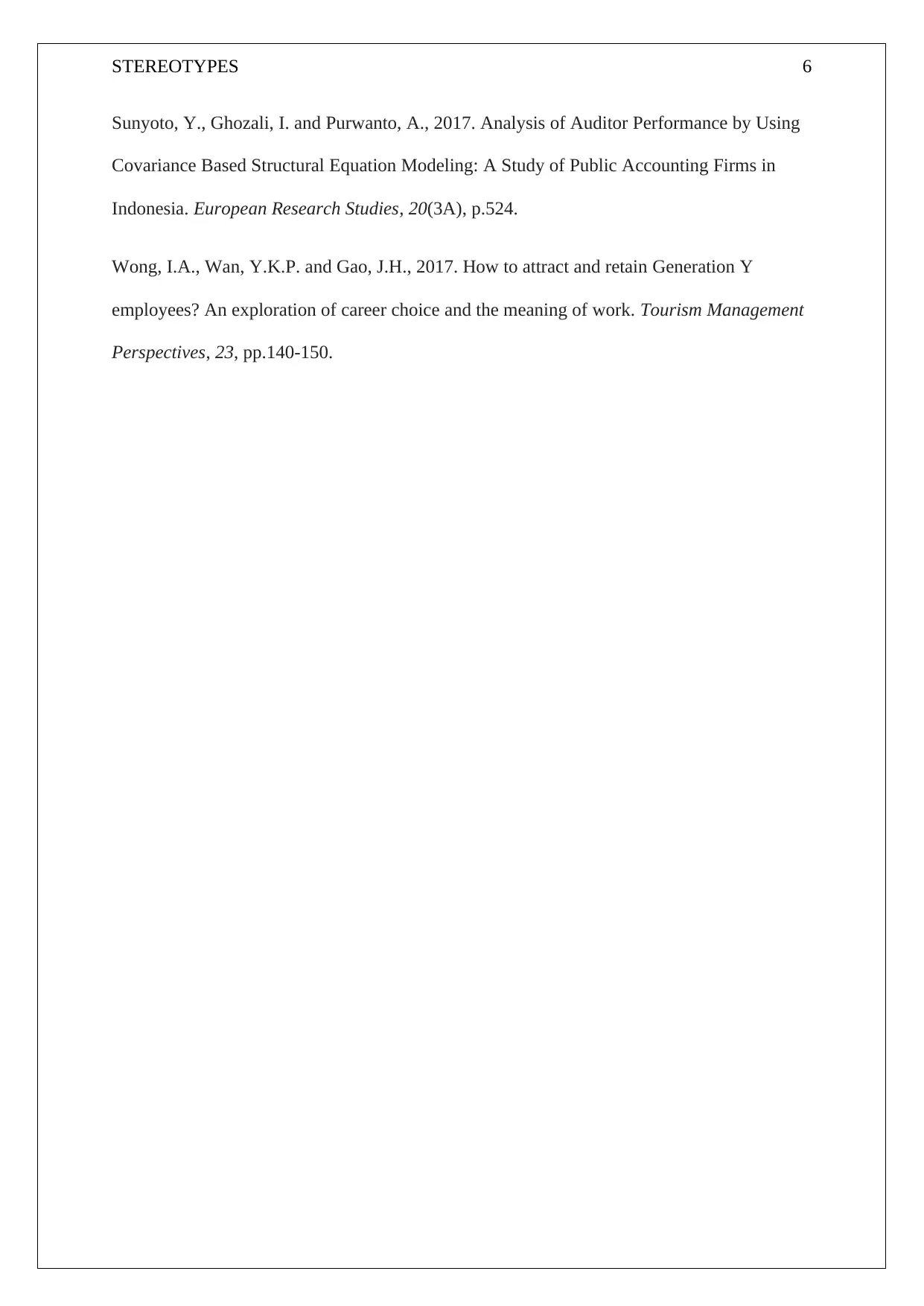
STEREOTYPES 6
Sunyoto, Y., Ghozali, I. and Purwanto, A., 2017. Analysis of Auditor Performance by Using
Covariance Based Structural Equation Modeling: A Study of Public Accounting Firms in
Indonesia. European Research Studies, 20(3A), p.524.
Wong, I.A., Wan, Y.K.P. and Gao, J.H., 2017. How to attract and retain Generation Y
employees? An exploration of career choice and the meaning of work. Tourism Management
Perspectives, 23, pp.140-150.
Sunyoto, Y., Ghozali, I. and Purwanto, A., 2017. Analysis of Auditor Performance by Using
Covariance Based Structural Equation Modeling: A Study of Public Accounting Firms in
Indonesia. European Research Studies, 20(3A), p.524.
Wong, I.A., Wan, Y.K.P. and Gao, J.H., 2017. How to attract and retain Generation Y
employees? An exploration of career choice and the meaning of work. Tourism Management
Perspectives, 23, pp.140-150.
1 out of 7
Related Documents
Your All-in-One AI-Powered Toolkit for Academic Success.
+13062052269
info@desklib.com
Available 24*7 on WhatsApp / Email
![[object Object]](/_next/static/media/star-bottom.7253800d.svg)
Unlock your academic potential
Copyright © 2020–2025 A2Z Services. All Rights Reserved. Developed and managed by ZUCOL.




